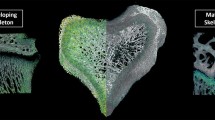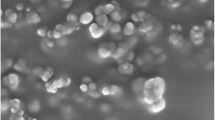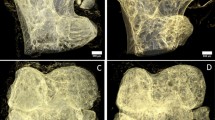Abstract
After internal contamination, uranium rapidly distributes in the body; up to 20 % of the initial dose is retained in the skeleton, where it remains for years. Several studies suggest that uranium has a deleterious effect on the bone cell system, but little is known regarding the mechanisms leading to accumulation of uranium in bone tissue. We have performed synchrotron radiation-based micro-X-ray fluorescence (SR μ-XRF) studies to assess the initial distribution of uranium within cortical and trabecular bones in contaminated rats’ femurs at the micrometer scale. This sensitive technique with high spatial resolution is the only method available that can be successfully applied, given the small amount of uranium in bone tissue. Uranium was found preferentially located in calcifying zones in exposed rats and rapidly accumulates in the endosteal and periosteal area of femoral metaphyses, in calcifying cartilage and in recently formed bone tissue along trabecular bone. Furthermore, specific localized areas with high accumulation of uranium were observed in regions identified as micro-vessels and on bone trabeculae. These observations are of high importance in the study of the accumulation of uranium in bone tissue, as the generally proposed passive chemical sorption on the surface of the inorganic part (apatite) of bone tissue cannot account for these results. Our study opens original perspectives in the field of exogenous metal bio-mineralization.


Similar content being viewed by others
References
Vidaud C, Bourgeois D, Meyer D (2012) Bone as target organ for metals: the case of f-elements. Chem Res Toxicol 25:1161–1175
Agency for Toxic Substances and Disease Registry (ATSDR) (2013) Toxicological profile for uranium. Available at http://www.atsdr.cdc.gov/toxprofiles/tp150.pdf. Accessed 1 Apr 2015
Orloff KG, Mistry K, Charp P, Metcalf S, Marino R, Shelly T, Melaro E, Donohoe AM, Jones RL (2004) Human exposure to uranium in groundwater. Environ Res 94:319–326
Wetterlind J, Richer De Forges AC, Nicoullaud B, Arrouays D (2012) Changes in uranium and thorium contents in topsoil after long-term phosphorus fertilizer application. Soil Use Manage 28:101–107
Neuman WF, Neuman MW, Main ER, Mulryan BJ (1949) The deposition of uranium in bone. 4. Adsorption studies in vitro. J Biol Chem 179:325–333
Priest ND, Howells GR, Green D, Haines JW (1982) Uranium in bone: metabolic and autoradiographic studies in the rat. Human Toxicol 1:97–114
Austin AL, Ellender M, Haines JW, Harrison JD, Lord BI (2000) Microdistribution and localized dosimetry of the α-emitting radionuclides 239Pu, 241Am and 233U in mouse femoral shaft. Int J Radiat Biol 76:101–111
McRae R, Bagchi P, Sumalekshmy S, Fahrni CJ (2009) In situ imaging of metals in cells and tissues. Chem Rev 109:4780–4827
Doublier A, Farlay D, Khebbab MT, Jaurand X, Meunier PJ, Boivin G (2011) Distribution of strontium and mineralization in iliac bone biopsies from osteoporotic women long-term treated with strontium ranelate. Eur J Endocrinol 165:469–476
Majumdar S, Peralta-Videa JR, Castillo-Michel H, Hong J, Rico CM, Gardea-Torresdey JL (2012) Applications of synchrotron μ-XRF to study the distribution of biologically important elements in different environmental matrices: a review. Anal Chim Acta 755:1–16
Pemmer B, Roschger A, Wastl A, Hofstaetter JG, Wobrauschek P, Simon R, Thaler HW, Roschger P, Klaushofer K, Streli C (2013) Spatial distribution of trace elements zinc, strontium and lead in human bone tissue. Bone 57:184–193
Behets GJ, Verberckmoes SC, Oste L, Bervoets AR, Salomé M, Cox AG, Denton J, De Broe ME, D’Haese PC (2005) Localization of lanthanum in bone of chronic renal failure rats after oral dosing with lanthanum carbonate. Kidney Int 67:1830–1836
Vergucht E, De Samber B, Izmer A, Vekemans B, Appel K, Tolmachev S, Vincze L, Vanhaecke F (2015) Study of the distribution of actinides in human tissues using synchrotron radiation micro X-ray fluorescence spectrometry. Anal Bioanal Chem 407:1559–1566
Garrevoet J, Vekemans B, Tack P, De Samber B, Schmitz S, Brenker FE, Falkenberg G, Vincze L (2014) Methodology toward 3D micro X-ray fluorescence imaging using an energy dispersive charge-coupled device detector. Anal Chem 86:11826–11832
Leydier A, Lecercle D, Pellet-Rostaing S, Favre-Reguillon A, Taran F, Lemaire M (2013) Sequestering agent for uranyl chelation: new binaphtyl ligands. Tetrahedron Lett 52:3973–3977
Chatelain G, Bourgeois D, Ravaux J, Averseng O, Vidaud C, Meyer D (2015) Incorporation of uranium into a biomimetic apatite: physicochemical and biological aspects. J Biol Inorg Chem 20:497–507. doi:10.1007/s00775-014-1231-5
Qi L, Basset C, Averseng O, Quemeneur E, Hagege A, Vidaud C (2014) Characterization of UO2 2+ binding to osteopontin, a highly phosphorylated protein: insights into potential mechanisms of uranyl accumulation in bones. Metallomics 6:166–176
Basset C, Averseng O, Ferron PJ, Richaud N, Hagège A, Pible O, Vidaud C (2013) Revision of the biodistribution of uranyl in serum: is fetuin-A the major protein target? Chem Res Toxicol 26:645–653
Geraki K, Farquharson MJ, Bradley DA, Gundogdu O, Falkenberg G (2008) The localisation of biologically important metals in soft and calcified tissues using a synchrotron X-ray fluorescence technique. X-Ray Spectrom 37:12–20
Roschger A, Hofstaetter JG, Pemmer B, Zoeger N, Wobrauschek P, Falkenberg G, Simon R, Berzlanovich A, Thaler HW, Roschger P, Klaushofer K, Streli C (2013) Differential accumulation of lead and zinc in double-tidemarks of articular cartilage. Osteoarthr Cartil 21:1707–1715
Boivin G, Farlay D, Khebbab MT, Jaurand X, Delmas PD, Meunier PJ (2010) In osteoporotic women treated with strontium ranelate, strontium is located in bone formed during treatment with a maintained degree of mineralization. Osteoporos Int 21:667–677
Acknowledgments
We are grateful to the Deutsches Elektronen-Synchrotron facility (DESY, I-20130162 EC & I-20120547 EC projects) and to the ToxNuc program (BiomUrOs project) of the Commissariat à l’Energie Atomique et aux Energies Alternatives (CEA) for funding this work. J. Garrevoet and P. Tack are funded by a Ph.D. grant of the Agency for Innovation by Science and Technology (IWT). The SLcam detector was partially funded by the Funds for Scientific Research, Flanders (FWO), Belgium.
Author information
Authors and Affiliations
Corresponding author
Electronic supplementary material
Below is the link to the electronic supplementary material.
ESM 1
(PDF 185 kb)
Rights and permissions
About this article
Cite this article
Bourgeois, D., Burt-Pichat, B., Le Goff, X. et al. Micro-distribution of uranium in bone after contamination: new insight into its mechanism of accumulation into bone tissue. Anal Bioanal Chem 407, 6619–6625 (2015). https://doi.org/10.1007/s00216-015-8835-7
Received:
Revised:
Accepted:
Published:
Issue Date:
DOI: https://doi.org/10.1007/s00216-015-8835-7




